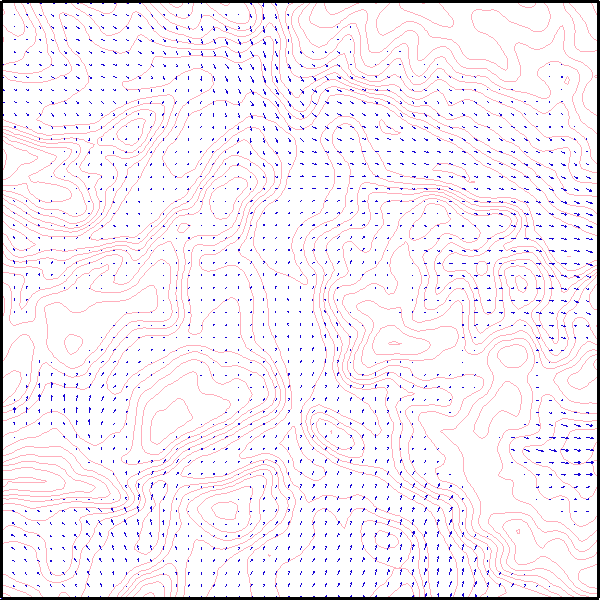ENSI can calculate the dispersion of radioactive substances
 The dispersion calculation can be used by the responsible emergency organisations (in particular ENSI and the National Emergency Operations Centre, NEOC) to predict the direction in which a radioactive cloud will move after its release from a nuclear power plant.
The dispersion calculation can be used by the responsible emergency organisations (in particular ENSI and the National Emergency Operations Centre, NEOC) to predict the direction in which a radioactive cloud will move after its release from a nuclear power plant.
When a release occurs, moreover, the calculation should make it possible to identify the areas that the radioactive cloud will reach, and when this will happen. This enables targeted deployment of the measuring instrumentation and the intervention forces; the population can then be alerted promptly by means of alarms so that they can take precautions to protect themselves.
In the preliminary phase, i.e. prior to the start of a release of radioactivity, there is no possibility of referring to measurements of radioactivity in the surrounding area. Instead, the hazard must be estimated with the help of model calculations based on the current situation in the plant as well as the weather conditions.
Dispersion calculations adapted to Swiss conditions
In case of an accident entailing a risk that radioactivity may be released into the surrounding area, ENSI uses the complex model for atmospheric dispersion calculations known as ADPIC (Atmospheric Diffusion Particle-In-Cell Model). ADPIC takes account of the topography and the local wind conditions.
ADPIC allows the direct use of 3-D wind fields from the COSMO2 model which, for its part, supplies forecasts with relatively high spatial resolution up to 24 hours in advance. When COSMO2 is used, the 3-D wind data are scaled down to the resolutions required by the dispersion model with the help of a standard wind field model.
The ADPIC dispersion model was developed by the Lawrence Livermore National Laboratory and was selected on the basis of a model evaluation carried out between 1990 and 1995. This evaluation was based on tracer experiments in the Gösgen area involving enrichment of the air with a substance so that the transported volumes could be measured. Extensive adaptations were required to enable operational deployment of this model in Switzerland, particularly in respect of the online acquisition of meteorological data, three-dimensional wind fields and the visualisation of the results.
Diagnosis and prognosis
In case of an incident, the ADPIC dispersion model permits a realistic assessment of the radiological hazard to the population on the basis of up-to-date meteorological data. For diagnostic calculations – i.e. the determination of dispersion that has already occurred – the data measured by the operational stations of MeteoSwiss (the Federal Office of Meteorology and Climatology) are used as input.
For prognostic calculations, i.e. forecasting, the COSMO2 forecasting model of MeteoSwiss is used. ADPIC is operational for diagnostic and prognostic calculations relating to all nuclear plants:
- Routine calculations with a single standard source (1 Bq/s Cs-137) are carried out automatically at hourly intervals round the clock, for three different release levels.
- In case of events and emergency exercises, incident-specific calculations can be expected no later than within the first hour of operational readiness of the ENSI emergency response organisation.
The main purposes of the routine calculations are to ensure that the system is continuously available, and to monitor the current dispersion situation (with forecasts for the next six hours). Moreover, routine calculations can be used for an initial assessment in case of an event.
The main purpose of incident-specific calculations in the preliminary and cloud phases is to assess the hazard to the population in the area surrounding the nuclear power plant in case of a previous or subsequent release of radioactive substances. These calculations serve as the basis for demarcating the area that may be at risk, and for decisions on any additional measurements and actions that may be necessary in order to protect the population.
Ongoing development of the models
The ADPIC programme that ENSI currently uses for dispersion calculations attained the last stage of its development in 2011. ADPIC corresponds to the latest state of the art and is internationally recognised. Ongoing development of the dispersion calculation system is essential so that demanding requirements for quality can continue to be met in the future.
For this reason, ENSI launched the RADUK project (Radiological Dispersion Calculations in the Areas Surrounding Nuclear Plants) in January 2011, so that ADPIC can be taken out of service and replaced by a modern system. With support from partner organisations − MeteoSwiss, the National Emergency Operations Centre (NEOC) and other foreign institutions − the European JRODOS platform (Java-based Real-time On-line Decision Support System) is due to be introduced at ENSI by the start of 2015 in combination with the LASAT (Lagrangian Simulation of Aerosol Transport) dispersion calculation programme. These steps will pave the way for the long-term continuation of a key emergency instrument.
Most important of all, the new system offers a wide range for simulations and synergies with the NEOC, MeteoSwiss and the EU. Other advantages include an improved cost-to-benefit ratio and a modern operating and visualisation interface.


